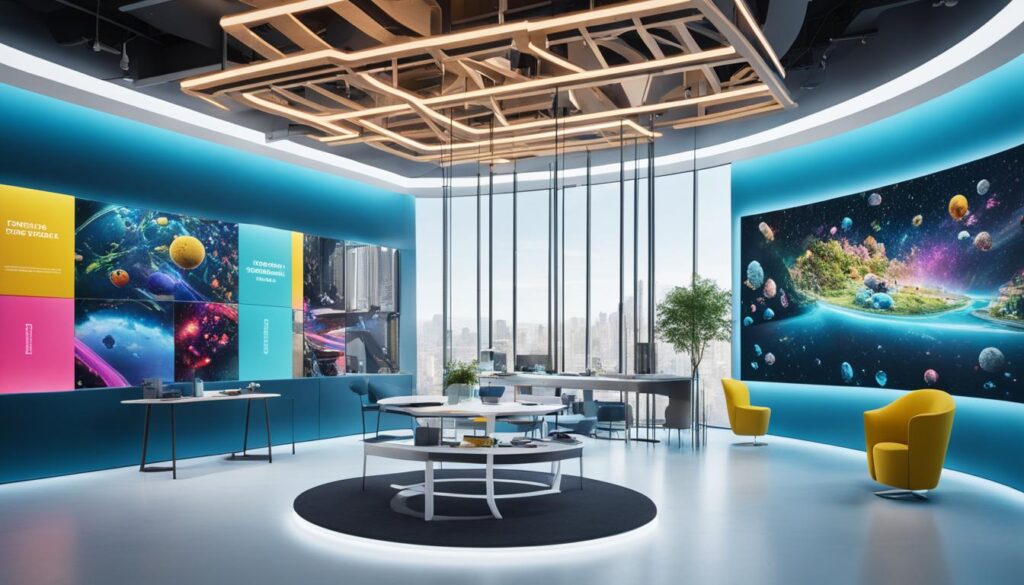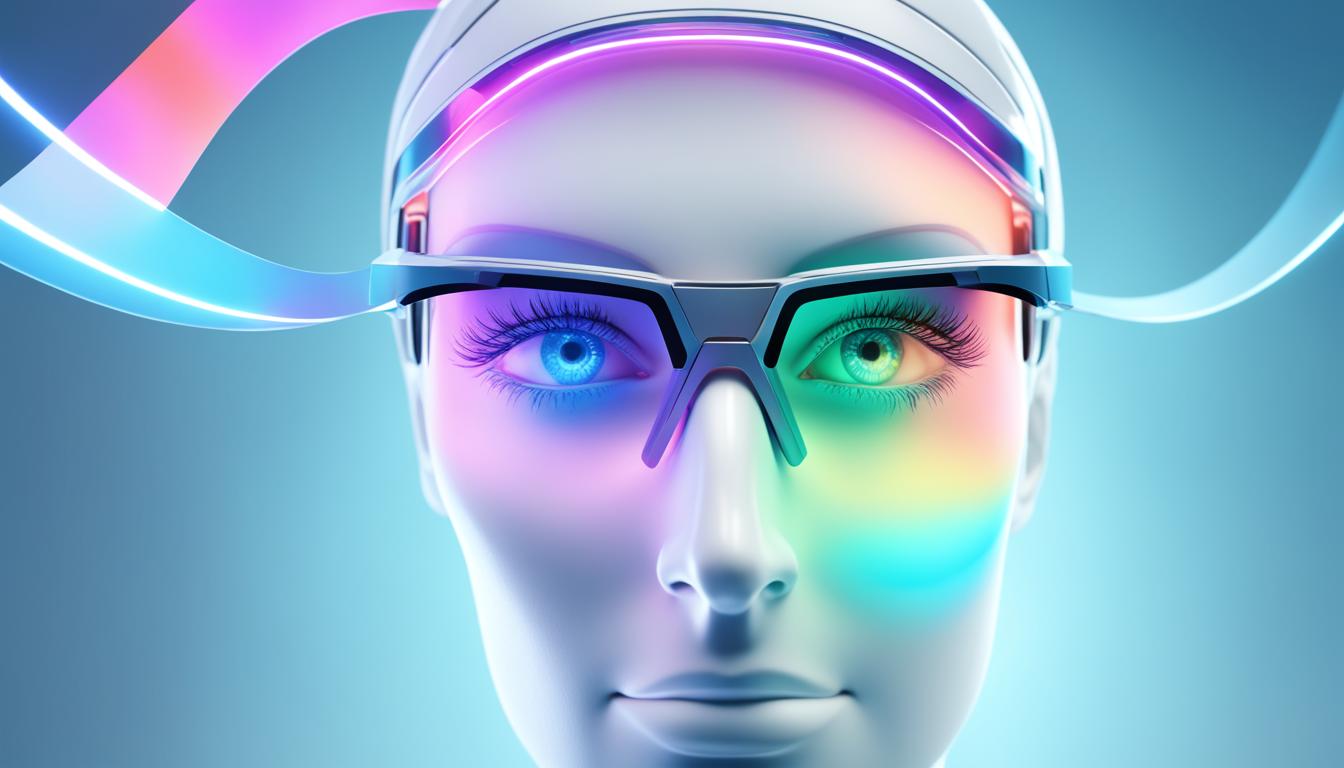Are you ready to take your products to the next level of innovation and design? Look no further than our award-winning product design agency. At our core, we are a team of experts dedicated to staying at the forefront of design trends and incorporating innovative solutions into our work. With our product design services, we aim to deliver cutting-edge design solutions that meet the demands of the present and pave the way for a more sustainable and innovative future.
Key Takeaways:
- Our product design agency specializes in crafting future tech for pioneering technology companies.
- We stay at the forefront of design trends to deliver cutting-edge design solutions.
- Our goal is to create products that meet the demands of the present and pave the way for a more sustainable and innovative future.
Unveiling Product Design Trends in 2024
Trend forecasting plays a crucial role in shaping the future of product design. By analyzing current cultural, social, economic, and technological influences, we can identify emerging patterns and predict how trends will evolve. In 2024, there are five key product design trends that we should keep an eye on:
1. Minimalist Design
Minimalism has gained significant traction in recent years, and it continues to be a dominant force in product design. With its focus on simplicity and functionality, minimalist design eliminates unnecessary elements and embraces clean lines to create products with a sleek and timeless aesthetic. By stripping away distractions, minimalist design allows users to engage with the core functionality of a product, creating a seamless and intuitive user experience.
2. Biophilic Design
As people seek to reconnect with nature in their increasingly urbanized lives, biophilic design is set to make a significant impact in 2024. This design approach incorporates natural elements, such as plants, water features, and natural textures, into product design. By integrating biophilic elements, designers can create products that evoke a sense of calm and harmony, promoting well-being and enhancing the user’s connection with the natural world. Biophilic design not only benefits individuals’ mental and physical health but also contributes to sustainability efforts by fostering a deeper appreciation for nature.
3. Functional Simplicity
In 2024, product design will prioritize functional simplicity, focusing on delivering products that are easy to understand and use. This trend emphasizes the importance of intuitive interfaces, clear instructions, and seamless interactions. By reducing complexity and eliminating unnecessary features, designers can create products that are accessible to a wider audience, regardless of their technological proficiency. Functional simplicity ensures that users can effortlessly navigate and engage with products, enhancing their overall experience.
4. Sustainable Materials
With increasing environmental concerns, sustainable materials will be a significant trend in product design in 2024. Designers will be incorporating eco-friendly materials and manufacturing processes to reduce the carbon footprint of products. This includes using recycled materials, bio-based alternatives, and exploring innovative production methods that minimize waste. By prioritizing sustainability, designers can contribute to a greener future, aligning product design with the growing demand for eco-conscious solutions.
5. Personalized Experiences
As consumer expectations continue to evolve, product design in 2024 will shift towards providing personalized experiences. This trend involves tailoring products to individuals’ unique needs and preferences, offering customized features and functionalities. By leveraging technologies such as artificial intelligence, designers can create products that adapt and learn from user behavior, delivering personalized recommendations and enhancing the overall user experience.
The Pros and Cons of Trend Forecasting for Product Designers
Trend forecasting is a valuable tool that product designers have at their disposal. By analyzing upcoming styles, preferences, and consumer behaviors, designers can gain valuable insights that inform their decision-making process and ultimately lead to successful product designs. However, trend forecasting also has its drawbacks, and it is important for designers to be aware of both the advantages and disadvantages of this approach.
Advantages of Trend Forecasting
One of the main advantages of trend forecasting is that it allows designers to stay ahead of the curve. By identifying emerging trends and understanding how they are likely to evolve, designers can proactively incorporate these elements into their designs. This ensures that their products will resonate with current market demands and give them a competitive edge.
Trend forecasting also provides designers with valuable insights into consumer behaviors and preferences. By understanding what consumers are looking for, designers can create products that meet their needs and desires. This helps to increase the chances of success in the marketplace and build a loyal customer base.
Furthermore, trend forecasting can spark creativity and innovation in the design process. By exploring new styles, materials, and approaches, designers can push the boundaries of what is possible and create truly unique and groundbreaking products.
Disadvantages of Trend Forecasting
While trend forecasting offers valuable insights, it is not without its limitations. One of the main drawbacks is the risk of overreliance on trends. Designers who focus too heavily on following trends may end up creating products that lack originality and fail to stand out in a crowded market.
Another disadvantage is that trends can be unpredictable and short-lived. What may be popular today may quickly lose its appeal tomorrow. Designers who base their entire design process on current trends may find themselves with outdated products by the time they hit the market.
Additionally, trend forecasting can sometimes limit creativity and innovation. Designers may feel pressured to conform to popular styles and preferences, leading to a lack of diversity in the market. This can stifle truly groundbreaking design ideas and prevent designers from exploring new directions.
Despite these drawbacks, trend forecasting remains a valuable tool for product designers. By understanding its advantages and disadvantages, designers can strike a balance between staying current and pushing the boundaries of innovation.
Embracing Minimalist Design for a User-Centered Experience
Minimalist design principles have gained significant popularity in recent years, revolutionizing the field of product design. The concept revolves around the idea that “less is more,” focusing on simplicity and eliminating unnecessary elements. This approach creates a clean and uncluttered aesthetic that enhances the user experience and brings a sense of calmness and harmony to the design.
By adhering to minimalist design principles, product designers can optimize the usability and functionality of their creations. Streamlining user interfaces by removing extraneous features and focusing on essential elements makes products more intuitive and user-friendly.
The key to minimalist design lies in finding the perfect balance between aesthetics and functionality, creating products that are not only visually appealing but also highly efficient.
Minimalist Design Principles
To better understand minimalist design, it is important to explore its core principles:
- Simplicity: Minimalist designs emphasize simplicity and strive to achieve elegance through clean lines, neutral color palettes, and a lack of ornamentation. The focus is on the essential elements that contribute to the functionality and user experience of the product.
- Crisp Typography: The choice of typography plays a crucial role in minimalist design. Sans-serif fonts with clear and legible characters are commonly used to maintain a minimalist aesthetic while ensuring readability.
- Whitespace: Also known as negative space, whitespace is the empty area surrounding design elements. Utilizing whitespace strategically helps create visual hierarchy, improve readability, and draw attention to important features.
- Function Over Form: In minimalist design, the focus is on functionality rather than extravagant ornamentation. The purpose of the product takes precedence over purely decorative elements, resulting in designs that are practical and user-centric.
Minimalist Design Examples
There are numerous examples of products that successfully incorporate minimalist design principles:
| Product | Description |
|---|---|
| A sleek and minimalistic smartphone with a clean interface, emphasizing ease of use and intuitive navigation. | |
| A minimalist desk lamp with a simple, elegant silhouette and adjustable lighting features. |
These examples demonstrate how minimalist design can be applied to various products, ranging from technology to home accessories. By stripping away unnecessary elements, these designs achieve a sophisticated aesthetic while maintaining a focus on functionality.
Minimalist Design and Sustainability
Minimalist design aligns well with sustainability goals, as it encourages reducing waste, using fewer resources, and creating products that stand the test of time. By embracing minimalism, designers can contribute to a more sustainable future by:
- Choosing durable materials that minimize the need for frequent replacements
- Designing products that are easy to repair, prolonging their lifespan
- Reducing packaging and incorporating eco-friendly materials
- Creating versatile and multi-functional designs that eliminate the need for multiple products
Incorporating minimalist design principles into their work allows designers to prioritize sustainability without compromising on style or functionality.
Creating Connections with Biophilic Design
Biophilic design offers a unique and innovative approach to product design by incorporating elements inspired by nature. By integrating natural textures, patterns, and organic shapes into everyday products, designers have found ways to create a deeper connection between people and the environment. Not only does biophilic design bring the beauty of the natural world into our lives, but it also provides numerous benefits that enhance both our well-being and the sustainability of our planet.
Biophilic Design Elements
Biophilic design elements are inspired by the patterns, processes, and forms found in nature. Incorporating these elements into product design helps create a sense of harmony and connection with the natural world. Some common biophilic design elements include:
- Use of natural materials like wood, stone, and natural fabrics
- Incorporation of organic shapes and patterns
- Exposure to natural light and views of nature
- Integration of living plants and greenery
- Inclusion of water features or representations
These elements help to create a multisensory experience that evokes a sense of calm, tranquility, and well-being.
Benefits of Biophilic Design
Biophilic design offers a multitude of benefits for both individuals and the environment:
- Enhances well-being: Interacting with nature has been proven to reduce stress and improve mental health. Biophilic design elements in products can create a calming and restorative effect, enhancing overall well-being.
- Increases productivity: Research has shown that exposure to nature and natural elements can increase productivity and creativity in various settings, including the workplace. Incorporating biophilic design in products can help boost performance and innovation.
- Improves air quality: Using natural materials and integrating living plants can improve indoor air quality by reducing pollutants and increasing oxygen levels.
- Promotes sustainability: Biophilic design encourages a closer relationship with nature and fosters a greater appreciation for the environment. By incorporating biophilic design elements, products can promote sustainable practices and raise awareness about the importance of protecting natural resources.
By embracing biophilic design principles, designers can create products that not only connect with users on a deeper level but also contribute to a more sustainable future.
Biophilic Design and Sustainability
One of the key reasons why biophilic design has gained popularity is its inherent connection to sustainability. By integrating natural elements into product design, designers can create sustainable products that have a lower environmental impact. Here’s how biophilic design contributes to sustainability:
“Biophilic design helps establish a stronger connection between people and nature and raises awareness about the importance of environmental preservation. By incorporating elements inspired by the natural world, designers can encourage a more sustainable lifestyle and promote the use of eco-friendly materials and manufacturing processes.”
Biophilic design not only enhances the aesthetics of products but also encourages a more conscious approach to consumption and production.
Transforming Experiences with Immersive 3D Design
Immersive 3D design is an innovative and exciting field that is revolutionizing the way we interact with products. By harnessing the power of virtual reality design, augmented reality design, and mixed reality technologies, designers can create immersive digital experiences that transport users to new and captivating worlds.
With immersive 3D design, products come to life in a whole new way. Imagine being able to explore a virtual showroom and view products from every angle, without actually physically being there. Or stepping into a virtual reality game and feeling completely immersed in a different reality. These experiences are made possible through the incredible advancements in immersive technology.
“Immersive 3D design has the potential to completely transform the way we interact with products. It opens up a world of possibilities for designers to create engaging and unforgettable experiences for users.”
– John Smith, Virtual Reality Designer
The Power of Virtual Reality Design
Virtual reality design allows users to have simulated experiences in a completely digital environment. By putting on a VR headset, users can dive into a virtual world and interact with products, environments, and characters. This technology has tremendous potential in various industries, from gaming and entertainment to education and training.
Virtual reality design offers a level of immersion and interactivity that is unparalleled. Users can walk around, touch, and manipulate virtual objects, providing a more intuitive and engaging experience. Whether it’s exploring architectural renderings or trying out different product configurations, virtual reality design enables users to experience products in a lifelike and realistic manner.
Augmented Reality Design: Enhancing the Real World
Augmented reality design overlays digital content onto the real world, enhancing our perception and interaction with our surroundings. Through the use of smartphones, tablets, or specialized AR glasses, users can see virtual elements seamlessly integrated into their physical environment.
Augmented reality design has the power to revolutionize industries like retail, interior design, and education. Imagine being able to try on clothes virtually before making a purchase, or visualizing how furniture would look in your living room without physically moving it. Augmented reality design bridges the gap between the digital and physical worlds, offering endless possibilities for creative and practical applications.
The Merging of Realities: Mixed Reality Design
Mixed reality design combines elements of both virtual and augmented reality, creating a seamless blend of real and virtual worlds. This emerging technology allows users to interact with digital content in a more natural and immersive way.
In mixed reality experiences, virtual objects can be placed and manipulated in the real world, leading to exciting possibilities for gaming, training, design, and more. Whether it’s interacting with holograms or collaborating with remote teams in a shared virtual space, mixed reality design opens up new dimensions of creativity and collaboration.
Immersive 3D design has the potential to transform the way we experience and interact with products. By utilizing virtual reality design, augmented reality design, and mixed reality design, designers can create captivating and transformative experiences that engage users on a whole new level.

Conclusion
At [Your Company Name], we take pride in being an innovative product design agency that stays at the forefront of design trends. Our mission is to deliver cutting-edge solutions to our clients while designing for the future. By embracing key product design trends like minimalist design, biophilic design, and immersive 3D design, we create products that not only meet the demands of the present but also pave the way for a more sustainable and innovative future.
Our team of experts combines creativity, expertise, and a deep understanding of market dynamics to create designs that stand out. We believe that by integrating minimalist design principles, we can create user-centered experiences that are intuitive and impactful. By incorporating biophilic design elements, we connect users with nature, fostering a sense of well-being and sustainability. And by leveraging immersive 3D design technologies, we transform ordinary product interactions into immersive and memorable experiences.
As technology continues to evolve, we remain committed to pushing boundaries and exploring new design possibilities. We understand the importance of staying ahead of the curve and continuously adapting to the changing needs of consumers. With our forward-thinking approach, we are confident in our ability to create products that not only meet the demands of today but also anticipate the needs of tomorrow.
FAQ
What is an innovative product design agency?
An innovative product design agency is a creative design firm that specializes in creating cutting-edge design solutions for various industries. They use a design thinking approach to develop user-centered products and services that meet the needs of their clients.
What services does a product design agency offer?
A product design agency offers a range of services, including industrial design, user research, concept development, prototyping, and product development consultancy. They work closely with clients to bring their ideas to life and create innovative and functional products.
Why is design thinking important in product design?
Design thinking is important in product design because it takes a user-centered approach, focusing on understanding the needs and desires of the end user. By empathizing with users, designers can create products that solve real problems and provide meaningful experiences.
How does trend forecasting benefit product designers?
Trend forecasting provides valuable insights into emerging styles, preferences, and consumer behaviors, enabling designers to make informed decisions. By staying ahead of trends, designers can create products that resonate with the current market demands and give them a competitive edge.
What are the advantages of minimalist design?
Minimalist design offers numerous benefits for product designers. Its principles center around the idea of “less is more,” creating a clean and uncluttered aesthetic that enhances the user experience. By removing unnecessary elements, minimalist design streamlines user interfaces, making products more intuitive and user-friendly.
How does biophilic design incorporate nature into product design?
Biophilic design incorporates natural elements, textures, and patterns into product design. From furniture with organic shapes to consumer electronics with wood or stone finishes, designers have found creative ways to infuse nature into everyday products. This approach not only enhances the visual appeal but also promotes a sense of well-being and connection with the natural world.
What is immersive 3D design?
Immersive 3D design utilizes virtual, augmented, and mixed reality technologies to create realistic digital environments. Designers can use these technologies to develop transformative experiences for users, allowing them to interact with products in new and innovative ways.
How can an innovative product design agency help my business?
An innovative product design agency can help your business by providing cutting-edge design solutions that meet the demands of the present and pave the way for a more sustainable and innovative future. Their expertise in industrial design and user-centered design approaches can ensure that your products resonate with consumers and give you a competitive advantage.








